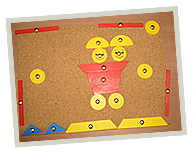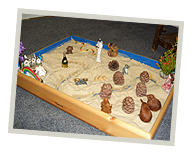For Children’s Services
How do I find out which is the appropriate service for my child? Should I refer my child for therapeutic services, or for music services to help with general development?
Play Therapy is used as an intervention when emotional or behaviour issues are needing to be addressed. Play Therapy is offered in ‘batches’ – normally 10-12 sessions are provided before a review stage is reached. On the other hand, general music sessions that focus on areas of a child’s development are provided as often as required, or as requested by parents/carers, with no specific review stage or time frame. This is discussed at consultation stage, if parents are unsure, and the therapist advises on which approach might best suit the child.
My child is autistic - how can play therapy help?
From my experience in providing play therapy to autistic children in mainstream school settings, I have found that where frustration or emotional issues may be affecting behaviour in the classroom or at home, then play therapy can often help address these frustrations, allowing a soothing or calming of the child, with stronger coping mechanisms often being adopted by the child.
My child has special needs, and I would like to use music more at home with her, to see if that will help her in any way – how do I find out more information about what I can do at home?
At the initial consultation, information is provided about options to explore – it may be that a small series of ‘family’ sessions is appropriate (30 minute sessions with parent and child) to demonstrate different ways of using music, and to give ideas for activities to do at home, that can be tailored specifically to the child’s needs. Home materials can be provided, if wished, to help reinforce particular activities and to present realistic challenges for the child, and to make the musical experience an enjoyable one. Advice can also be given regarding appropriate instruments to use at home. If the child is not able to hold instruments themselves, then we look at other ways to introduce musical interaction, with the support of the parent/carer.
I would like my child to receive play therapy sessions, but I am not able to travel to the Play Room at Thelwall – can help still be arranged?
 Home visits can be made within a certain radius, and the therapist can bring all materials to the home for the child’s play therapy session – please contact for more information about this arrangement. Another alternative is to check with the child’s school to see if permission can be given for sessions to be held there, during school hours, and whether there is a room available at the school that can be used.
Home visits can be made within a certain radius, and the therapist can bring all materials to the home for the child’s play therapy session – please contact for more information about this arrangement. Another alternative is to check with the child’s school to see if permission can be given for sessions to be held there, during school hours, and whether there is a room available at the school that can be used.
I think my child may benefit from having Play Therapy sessions – but how do I know for sure that the therapy will help?
As with any therapeutic intervention, it is not possible to know up front what the results of having therapy may be. PTUK statistics show that up to 83% of children receiving play therapy can experience a positive change. However, it is not possible within the first few sessions to know whether your child will be within the 83% experiencing a positive change, or whether your child will be within the 17% where no change is perceived. Play Therapy is a process, and requires time for the intervention. At review stage, after 10-12 sessions, an assessment takes place to see if there have been any shifts in the scoring of the following difficulty areas: conduct, relations with peers, emotional issues and hyperactivity. This allows us to assess whether play therapy has been effective in each case. For children who have higher overall difficulty scores, there may be 2 or 3 review stages; for children with slight to moderate difficulties, there may need to be only one review stage – it depends on the child’s unique interaction with the therapy itself.
For Therapeutic Sandplay Services
Will I need to give you a lot of information about myself – will you ask a lot of questions?
Therapeutic Sandplay is primarily a non-verbal therapy – there is no need to provide the therapist with background or historical information about yourself, if you do not wish to have these discussed. There is no need to talk while ‘making a sand tray’. However, if you think it would be helpful for the therapist to know about anything in particular, that information can be passed over to the therapist at any stage. All information given within a therapeutic setting is confidential.
If I have an issue on my mind, do I have to make a sand tray that obviously
reflects that issue?
The sandplay process can operate at both conscious and unconscious levels. You make whatever you wish to make in the sand tray, at that particular moment. At first, it may feel a little strange (as making a sand tray is not something we might be familiar with!) but we can soon get used to how the session ‘feels’. At all times, the therapist will want to make sure the client feels comfortable when making the sand tray.
Will you tell me what the sand tray ‘picture’ means when I have finished it, at the end of the session?
 The therapist does not interpret the sand tray at the end of the session. Usually, a photograph is taken of the tray by the therapist, and this can be reviewed at a later stage, if wished by the client. Indeed, the sand may have been moved around the tray to give more of a 'moving image' than a 'static' picture. No questions are asked by the therapist while the sand picture is being made.
The therapist does not interpret the sand tray at the end of the session. Usually, a photograph is taken of the tray by the therapist, and this can be reviewed at a later stage, if wished by the client. Indeed, the sand may have been moved around the tray to give more of a 'moving image' than a 'static' picture. No questions are asked by the therapist while the sand picture is being made.
How can placing figures in a sand tray make me
feel better?
The sandplay process operates on both conscious and unconscious levels, and working with the sand can be a deep, emotional experience. When symbols are used and placed in the sand, this can be done on a conscious (cognitive) level, or an unconscious level (which means your hands have placed a certain item in the sand, but you may not have any explanation as to why that particular item has been picked). The client is normally able to know for themselves when a sand tray is ‘completed’, and they have finished the sand picture, or sand world.
How many sandplay sessions are required?
For people aged 18 years and above: it is up to the client to decide when a ‘process’ is complete. This could be after just a few sessions, or some clients continue the sessions for a longer period of time. Clients may leave a week or a fortnight between sessions, or longer – there is no suggested timeframe. It is up to the client. ‘You know when you have finished.’
For children and adolescents who choose to use sandplay as part of the Play Therapy process: 10-12 play therapy sessions are normally required before a review is undertaken.
I am interested in the sandplay sessions, but I have back problems – is there a lot of sitting on the floor/reaching over the sand tray?
The sand tray can be placed in various ways:
- On the floor, with client sitting on cushions
- On a low-level table, with client sitting in chair
- On a higher-level table (to reduce leaning over), with client sitting in chair
What happens when I want to review my sandplay photographs?
The client lets the therapist know that they wish to review any previous sandplay pictures, when making an appointment. The client can choose to discuss them with the therapist if they wish.
What is the Next Stage?
Contact Jane to arrange a consultation at Sandworlds in Thelwall, Warrington.